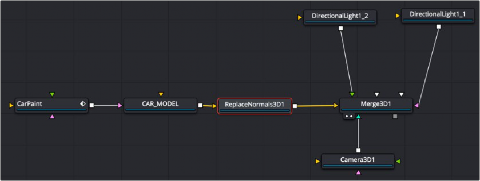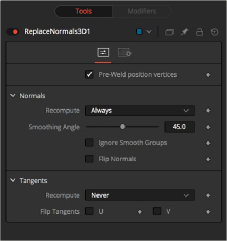
< Previous | Contents | Next >
The remaining controls for the Material and Settings tabs are common to many 3D nodes. Their descriptions can be found in “The Common Controls” section at the end of this chapter.
Replace Normals 3D [3RpN]

The Replace Normals 3D node
Replace Normals Node Introduction
In 3D modeling, normals are vectors used to determine the direction light reflects off surfaces. The Replace Normals node is used to replace the normals/tangents on incoming geometry, effectively adjusting the surface of an object between smooth and flat. All geometry connected to the scene input on the node is affected. Lights/Cameras/PointClouds/Locators/Materials, and other non-mesh nodes are passed through unaffected. The normals/tangents affected by this node are Per-vertex normals/tangents, not Per-face normals/tangents. The input geometry must have texture coordinates in order for tangents to be computed. Sometimes geometry does not have texture coordinates, or the texture coordinates were set to All by the FBX import because they were not present on the FBX.
![]()
Inputs
The Replace Normals node has a single input for the 3D scene or incoming geometry.
— SceneInput: The orange scene input accepts a 3D scene or 3D geometry that contains the normal coordinates you want to modify.
Basic Node Setup
The Replace Normals 3D node is inserted directly after the 3D object or scene whose normals you want to modify. Below, it is used to smooth the material on an imported 3D model.

Replace Normals 3D used to smooth normals on 3D geometry
Inspector

Replace Normals 3D controls
Control Tab
The options in the Control tab deal with repairing 3D geometry and then recomputing normals/tangents.
Sometimes position vertices are duplicated in a geometry, even though they have the same position, causing normals/tangents to be miscomputed. The results of pre-welding are thrown away; they do not affect the output geometry’s position vertices.
![]()
Controls when normals/tangents are recomputed.
— Always: The normals on the mesh are always recomputed.
— If Not Present: The normals on the mesh are recomputed only if they are not present.
— Never: The normals are never computed. This option is useful when animating.
Adjacent faces with angles in degrees smaller than this value have their adjoining edges smoothed across. A typical value one might choose for the Smoothing Angle is between 20 and 60 degrees. There is special case code for 0.0f and 360.0f (f stands for floating-point value). When set to 0.0f, faceted normals are produced; this is useful for artistic effect.
If set to False, two faces that have different Smooth Groups are not smoothed across (e.g., the faces of a cube or the top surfaces of a cylinder have different Smooth Groups). If you check this On and set
the smoothing angle large enough, the faces of a cube are smoothed across. There is currently no way to visualize Smooth Groups within Fusion.
Flipping of tangents can sometimes be confusing. Flip has an effect if the mesh has tangent vectors. Most meshes in Fusion don’t have tangent vectors until they reach a Renderer 3D, though. Also, when viewing tangent vectors in the viewers, the tangent vectors are created if they don’t exist. The confusing thing is if you view a Cube 3D that has no tangent vectors and press the FlipU/FlipV button,
nothing happens. This is a result of there being no tangent vectors to create, but later the GL renderer can create some (unflipped) tangent vectors.

There are five items you should be aware of when dealing with normals.
#1 The FBX importer recomputes the normals if they don’t exist, but you can get a higher- quality result from the Replace Normals node.
#2 Bump maps can sometimes depend on the model’s normals. Specifically, when you simplify a complex high polygon model to a low polygon model + bump map, the normals and bump map can become “linked.” Recomputing the normals in this case can make the model look funny. The bump map was intended to be used with the original normals.
#3 Most primitives in Fusion are not generated with tangents; when needed, they are generated on the fly by a Renderer 3D and cached.
#4 Tangents currently are only needed for bump mapping. If a material needs bump mapping, then tangents are created. These tangents are created with some default settings (e.g., Smoothing Angle, and so on). If you don’t want Fusion automatically creating tangents, you can use the Replace Normals node to create them manually.
#5 All computations are done in the local coordinates of the geometries instead of in the coordinate system of the Replace Normals 3D node. This can cause problems when there is a non-uniform scale applied to the geometry before Replace Normals 3D is applied.
There are five items you should be aware of when dealing with normals.
#1 The FBX importer recomputes the normals if they don’t exist, but you can get a higher- quality result from the Replace Normals node.
#2 Bump maps can sometimes depend on the model’s normals. Specifically, when you simplify a complex high polygon model to a low polygon model + bump map, the normals and bump map can become “linked.” Recomputing the normals in this case can make the model look funny. The bump map was intended to be used with the original normals.
#3 Most primitives in Fusion are not generated with tangents; when needed, they are generated on the fly by a Renderer 3D and cached.
#4 Tangents currently are only needed for bump mapping. If a material needs bump mapping, then tangents are created. These tangents are created with some default settings (e.g., Smoothing Angle, and so on). If you don’t want Fusion automatically creating tangents, you can use the Replace Normals node to create them manually.
#5 All computations are done in the local coordinates of the geometries instead of in the coordinate system of the Replace Normals 3D node. This can cause problems when there is a non-uniform scale applied to the geometry before Replace Normals 3D is applied.
There are five items you should be aware of when dealing with normals.
#1 The FBX importer recomputes the normals if they don’t exist, but you can get a higher- quality result from the Replace Normals node.
#2 Bump maps can sometimes depend on the model’s normals. Specifically, when you simplify a complex high polygon model to a low polygon model + bump map, the normals and bump map can become “linked.” Recomputing the normals in this case can make the model look funny. The bump map was intended to be used with the original normals.
#3 Most primitives in Fusion are not generated with tangents; when needed, they are generated on the fly by a Renderer 3D and cached.
#4 Tangents currently are only needed for bump mapping. If a material needs bump mapping, then tangents are created. These tangents are created with some default settings (e.g., Smoothing Angle, and so on). If you don’t want Fusion automatically creating tangents, you can use the Replace Normals node to create them manually.
#5 All computations are done in the local coordinates of the geometries instead of in the coordinate system of the Replace Normals 3D node. This can cause problems when there is a non-uniform scale applied to the geometry before Replace Normals 3D is applied.
![]()
Common Controls
The Settings tab is common to many 3D nodes. The description of these controls can be found in “The Common Controls” section at the end of this chapter.